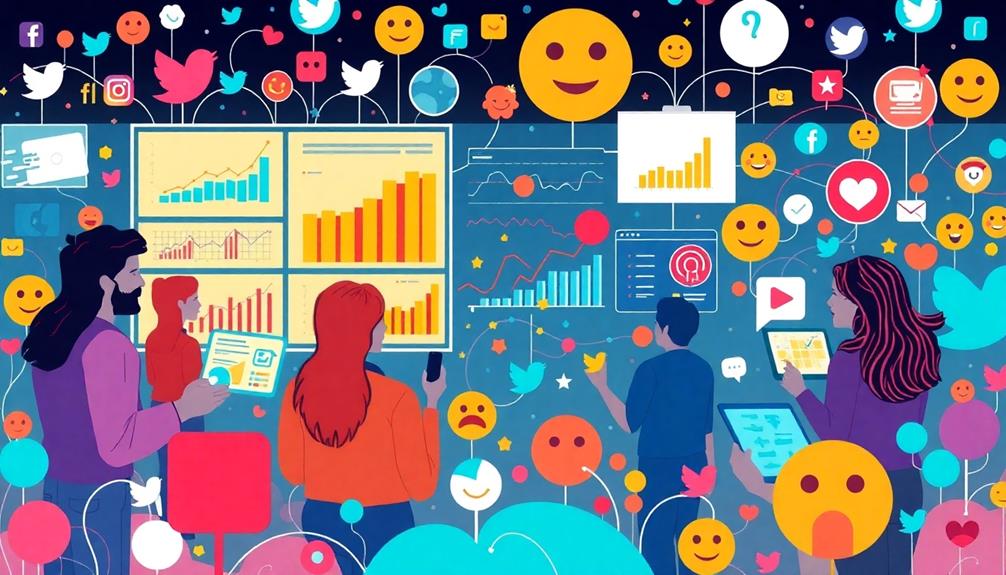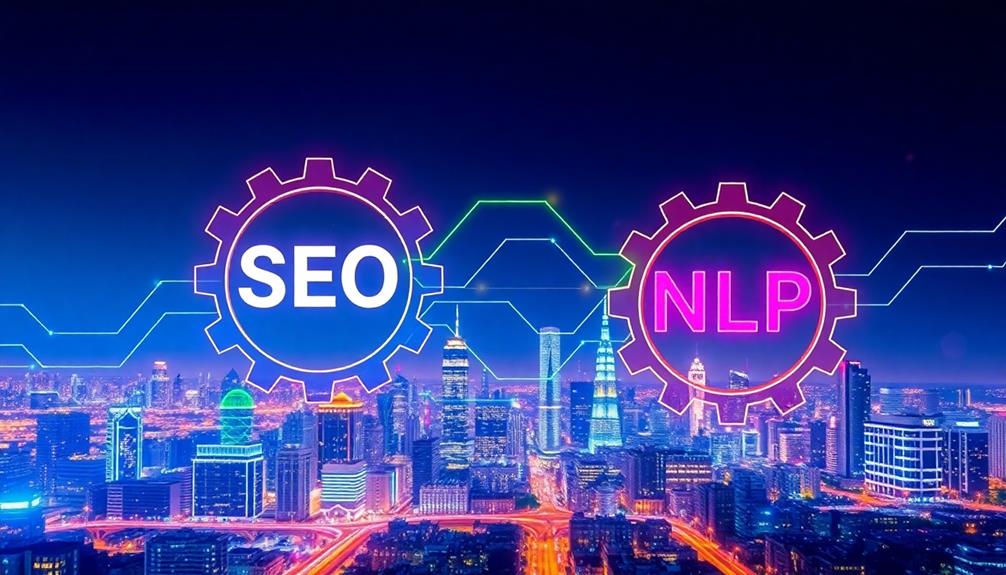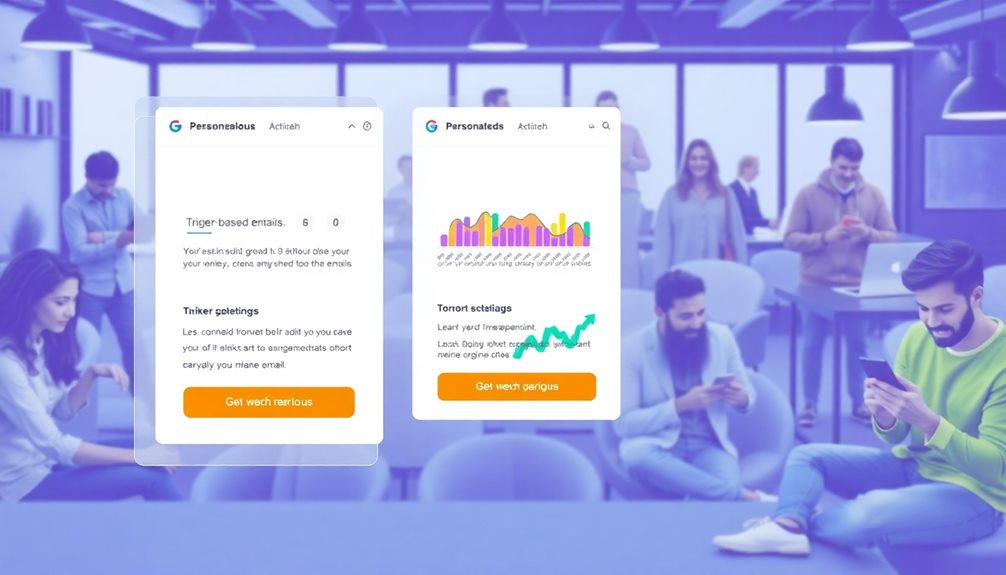To go pro with NLP and elevate your marketing, harness advanced techniques that refine your strategies. Leverage sentiment analysis to gauge customer emotions and tailor your messaging. Use NLP for hyper-personalized content that resonates with your audience, boosting engagement rates considerably. Implement behavior analysis to tweak your approach in real-time, maximizing relevance. Don't forget about SEO integration; optimizing your content helps you reach your target market effectively. By adopting these insights, you'll foster stronger connections and improve conversion rates. Discover even more game-changing techniques that can further optimize your marketing success.
Key Takeaways
- Utilize real-time sentiment analysis to gauge customer emotions and adjust marketing strategies for immediate impact.
- Implement advanced audience targeting through NLP to personalize messaging and boost engagement rates significantly.
- Leverage predictive analytics to forecast consumer behaviors, enhancing personalization and reducing churn effectively.
- Optimize content creation with NLP tools for tailored messaging, improving conversion rates and search engine visibility.
- Analyze behavioral patterns to dynamically adjust marketing approaches, ensuring relevance and higher customer engagement.
Understanding NLP Fundamentals

Natural Language Processing (NLP) is an indispensable technology that shapes how we interact with machines today. It enables machines to understand language, making it easier for you to communicate with them. At its core, NLP technology combines computer science, linguistics, and cognitive psychology to interpret and generate human language.
This capability is essential for creating applications like chatbots and voice recognition systems that enhance user experience. By utilizing data-driven marketing strategies, you can further refine how NLP is applied in your campaigns.
Key tasks within NLP include tokenization, part-of-speech tagging, and semantic analysis. These techniques help you grasp the structure and meaning of text, facilitating deeper insights into customer sentiment.
For instance, by analyzing customer feedback, you can pinpoint how your audience feels about your brand or product, allowing you to make informed decisions.
The evolution of NLP has greatly benefited from advancements in machine learning, particularly models like BERT, which improve context comprehension.
As you explore NLP fundamentals, you'll find that understanding these basic concepts is essential for leveraging its capabilities in your marketing strategies, enhancing audience targeting and content personalization.
NLP's Impact on Marketing

NLP transforms how you approach marketing by enhancing personalization strategies and enabling targeted content creation.
By leveraging advanced AI technologies, you can analyze vast amounts of customer data to tailor your messaging more effectively.
With real-time sentiment analysis, you can adjust your messaging to resonate with your audience's emotions instantly.
This powerful combination leads to more effective campaigns that truly connect with customers.
Enhanced Personalization Strategies
Harnessing advanced techniques in language processing can revolutionize how marketers engage with their audience. With NLP, you can analyze customer language patterns, allowing you to create hyper-personalized messaging that truly resonates with individual preferences and behaviors. This means you can craft messages that speak directly to your target audience, enhancing personalization in ways you mightn't have thought possible.
By implementing steps to authoritative content in your NLP strategies, you can guarantee that the content you create isn't only personalized but also highly relevant to your audience.
By segmenting your audience more effectively using nuanced interests identified through language use, you can improve your targeting precision. This leads to the delivery of relevant content that captures attention and drives engagement. In fact, personalized content generated through NLP can boost engagement rates by up to 50%.
When your messaging feels relevant and tailored, users are much more likely to respond positively.
Moreover, dynamic content personalization can lead to a 20% increase in conversion rates. Customers are more inclined to complete a purchase when they receive relevant product recommendations that align with their interests.
Real-Time Sentiment Analysis
Understanding consumer emotions in real-time can transform your marketing strategies considerably. By leveraging sentiment analysis powered by natural language processing (NLP), you can gauge customer feelings and opinions as they happen. This immediate insight allows you to adjust your campaigns dynamically, enhancing your responsiveness to customer needs.
With real-time sentiment analysis tools, you can tap into vast amounts of customer data from social media, reviews, and surveys. This analysis not only reveals public perception but also helps you identify emerging trends and potential issues in customer feedback before they escalate. The result? A more proactive approach to customer service.
Brands utilizing sentiment analysis have seen engagement increase by up to 30%, thanks to their ability to respond quickly to preferences and concerns. Moreover, integrating these insights into your marketing strategies can boost targeting and personalization efforts, potentially increasing conversion rates by as much as 20%.
In an era where voice recognition technology is becoming prevalent, combining it with sentiment analysis can additionally enhance your understanding of consumer emotions, ensuring your marketing strategies remain effective and relevant in real-time.
Targeted Content Creation
Targeted content creation is revolutionizing how marketers connect with their audiences, making it essential to leverage advanced technologies like natural language processing. By utilizing NLP, you can analyze customer language patterns to craft content that truly resonates with specific demographics. This isn't just about guessing what your audience wants; it's about understanding their language and preferences in-depth.
NLP enables you to perform sentiment analysis, allowing you to align your messages with current customer emotions. This approach markedly improves engagement rates, as you're speaking directly to what your audience feels.
Plus, using NLP tools helps generate optimized product descriptions and keywords, enhancing your visibility and driving organic traffic.
Personalization is another critical benefit of NLP. By tailoring content based on individual user interactions, you could see a reported 20% increase in conversion rates.
Additionally, leveraging NLP for competitive analysis allows you to identify trends and consumer sentiments around competitors, enabling you to adapt your content strategy for a competitive edge.
Incorporating NLP into your targeted content creation process can elevate your marketing efforts and foster stronger connections with your audience.
Advanced Audience Targeting

When it comes to advanced audience targeting, you can leverage demographic segmentation strategies, behavioral analysis techniques, and predictive analytics integration to sharpen your marketing efforts.
Demographic Segmentation Strategies
Demographic segmentation strategies empower marketers to connect with their audience on a deeper level by focusing on specific characteristics like age, gender, and income. By utilizing demographic segmentation, you can craft personalized messages that resonate with distinct groups. NLP aids in this process by analyzing language patterns in customer feedback and social media, allowing you to identify and target these segments effectively.
| Age Group | Preferred Content | Customer Service Expectations |
|---|---|---|
| 18-24 years | Engaging social media posts | Quick responses on platforms |
| 25-34 years | Informative blog articles | Personalized email communication |
| 35-50 years | Detailed product reviews | Extensive support options |
Research shows that targeted campaigns based on demographic segmentation can boost engagement rates by up to 300%. Advanced NLP techniques, like sentiment analysis, enable you to gauge emotional responses, tailoring your content marketing strategies. By leveraging these insights, you can optimize your marketing budget and focus on the most responsive audience segments, ensuring improved ROI and customer satisfaction.
Behavioral Analysis Techniques
Understanding consumer behavior is essential for effective marketing, as it allows you to tailor your strategies to meet the needs and preferences of your audience. By employing behavioral analysis techniques, you can leverage machine learning algorithms to identify and predict consumer behavior patterns based on historical data. This enables you to segment your audience more precisely.
Analyzing user interactions—like website navigation and social media engagement—helps you craft messaging that resonates with specific segments, boosting relevance and engagement rates. Additionally, sentiment analysis plays a vital role in evaluating customer feedback and reviews, providing insights into public sentiment towards your products or brand. This information guides your marketing strategies effectively.
Advanced behavioral targeting can enhance your click-through rates by up to 50% by delivering personalized content that aligns with individual consumer preferences and behaviors.
Integrating real-time data analytics allows you to dynamically adjust your campaigns based on live consumer behavior. This optimization not only improves performance but also maximizes your return on investment (ROI).
Predictive Analytics Integration
Harnessing predictive analytics can transform your audience targeting strategies by forecasting customer behaviors and preferences with remarkable accuracy. By leveraging historical data and machine learning algorithms, you can identify patterns in consumer interactions that reveal high-value segments. This allows you to create focused marketing campaigns that resonate with your audience's needs.
Integrating predictive analytics with NLP takes your strategies a step further. By interpreting user sentiment in real-time, you can craft personalized marketing experiences that engage customers more effectively. Businesses that adopt predictive analytics often see conversion rates increase by up to 20%, thanks to improved targeting and engagement.
Moreover, implementing predictive models can greatly reduce customer churn. By identifying at-risk customers early, you can intervene with timely strategies that encourage loyalty and retention. Imagine the impact on your bottom line if you could keep more customers happy and engaged.
Incorporating predictive analytics into your marketing toolkit not only enhances your audience targeting but also fosters deeper connections with your customers.
Embrace these advanced techniques to elevate your marketing game and drive measurable results.
Content Optimization Techniques

Effective content optimization techniques are essential for capturing audience attention and driving engagement in today's competitive digital landscape. By harnessing NLP, you can enhance your content optimization strategies considerably. Start by incorporating targeted keywords that resonate with your audience. This approach can boost your click-through rates by up to 20%, ensuring your content stands out.
Utilizing sentiment analysis tools powered by NLP allows you to tailor your content's tone and messaging in real-time, adapting to audience reactions. This responsiveness fosters deeper connections with your readers.
Additionally, automated content generation via NLP technologies can cut the time spent on crafting product descriptions by 50%, helping you launch products faster.
Don't forget the importance of SEO. Integrating NLP techniques into your SEO strategies can improve your search engine rankings, as Google prioritizes content that aligns with user intent.
Enhancing Customer Engagement

Enhancing customer engagement through advanced NLP techniques can transform how businesses interact with their audiences. By utilizing an NLP model, you can analyze customer interactions in real-time, allowing for prompt and effective responses to inquiries. This responsiveness can boost your engagement rates by up to 50%.
Moreover, leveraging sentiment analysis enables you to understand your customers' emotions better. By tailoring your marketing messages to resonate with these sentiments, you can achieve a 20% increase in customer satisfaction.
Personalized experiences are key to fostering deeper connections with your audience. By harnessing NLP-driven insights, you can create content that speaks directly to individual preferences, resulting in a 15% boost in repeat purchases and long-term loyalty.
Implementing chatbots powered by NLP further enhances engagement. These systems provide 24/7 customer support, greatly reducing response times and increasing engagement by up to 40%.
Leveraging Sentiment Analysis

Understanding your customers' emotions can greatly refine your marketing strategies. By leveraging sentiment analysis, you can gain real-time insights into how your audience feels about your products and brand.
This powerful tool uses NLP techniques to evaluate the emotional tone behind words, enabling you to craft effective marketing messages tailored to customer sentiments.
Here are some key benefits of incorporating sentiment analysis into your marketing:
- Identify positive, negative, or neutral sentiments in customer feedback.
- Personalize marketing messages based on the emotional state of your audience.
- Engage with customers in a timely and relevant manner.
- Enhance customer satisfaction by 20% through targeted strategies.
- Utilize advanced sentiment analysis models like BERT for improved accuracy.
Integrating NLP With SEO

Integrating NLP with SEO transforms how you approach online visibility and content strategy. By leveraging NLP algorithms, like Google's BERT, you can optimize keyword research, identifying synonyms and related phrases that enhance your content's relevance and search visibility. This allows your strategy to align more closely with user intent, ensuring that search engines recognize the context behind queries.
Utilizing sentiment analysis through NLP also empowers you to gauge audience reactions to your content. This insight lets you make real-time adjustments to your SEO strategies, enhancing engagement and response rates.
Additionally, by analyzing user-generated content, NLP can reveal trending topics and common questions, guiding your content creation to resonate with current audience interests.
Implementing NLP tools can greatly boost your on-page SEO. These tools generate keyword-rich suggestions for essential elements like meta descriptions and title tags, ensuring they resonate with your target demographics.
Future Trends in NLP Marketing

As you look to the future of NLP marketing, the landscape is rapidly evolving with technology advancements that promise to reshape how brands connect with consumers.
NLP has become an integral part of digital marketing strategies, enabling personalized experiences that resonate with individual preferences.
Here are some key trends to watch:
- AI-driven NLP tools will see a market growth of over 20% annually, enhancing personalization.
- Advanced sentiment analysis will help brands tailor communications, as 72% of consumers prefer personalized messages.
- Voice search optimization is essential, with projections indicating that 55% of households will own smart speakers by 2025.
- Real-time customer insights will allow brands to adjust their strategies based on immediate feedback and trends.
- Data privacy compliance will rely on NLP to guarantee ethical usage and maintain consumer trust.
Frequently Asked Questions
What Is NLP in Marketing?
NLP in marketing involves using algorithms to analyze customer language, helping you tailor messaging and enhance engagement. It allows for personalized strategies, sentiment analysis, and improved customer interactions through automated solutions like chatbots, optimizing your marketing efforts.
What Is Advanced NLP?
Advanced NLP refers to sophisticated techniques that enhance language understanding through deep learning models. You can leverage these methods for sentiment analysis, automated content generation, and improved customer interactions, making your marketing strategies more effective and engaging.
How Can NLP Be Used to Improve Customer Feedback Analysis?
Imagine a magnifying glass revealing hidden gems in customer feedback. You can use NLP to extract sentiment scores, categorize themes, and pinpoint specific opinions, transforming raw data into actionable insights that enhance your product offerings.
How to Use Natural Language Processing (Nlp) for Modern SEO?
You can use NLP to enhance modern SEO by analyzing user intent, optimizing for voice search, automating meta descriptions, and leveraging sentiment analysis. This'll help you create content that truly resonates with your audience.
Conclusion
Incorporating NLP into your marketing strategy isn't just an option; it's a game changer. By mastering audience targeting, optimizing content, and enhancing engagement, you're not just keeping pace—you're setting the pace. Embrace sentiment analysis, integrate with SEO, and stay ahead of future trends. As you elevate your marketing, remember: the more you know, the more you grow. So, plunge into, explore, and transform your approach—because the future of marketing is powered by NLP.










